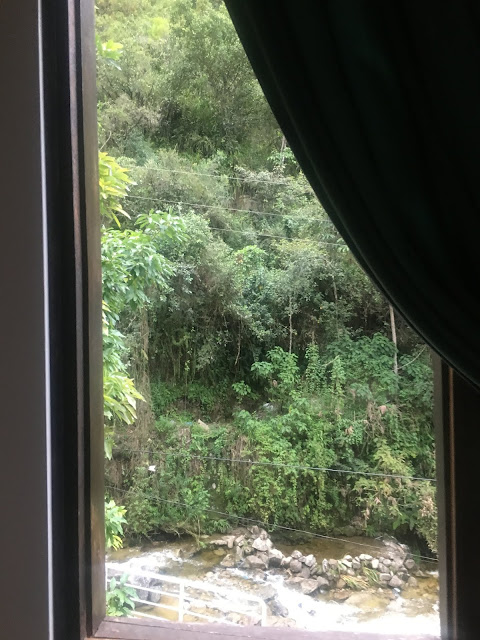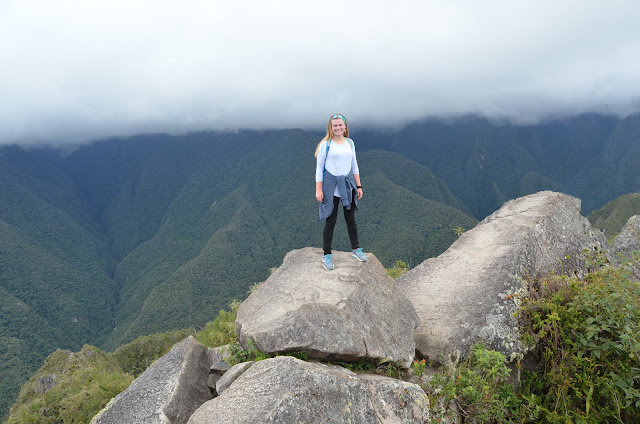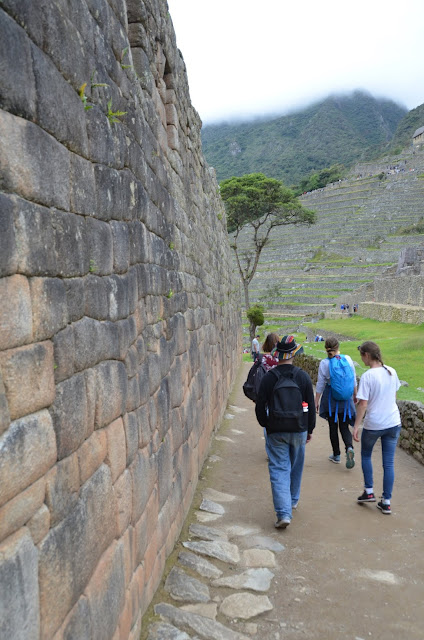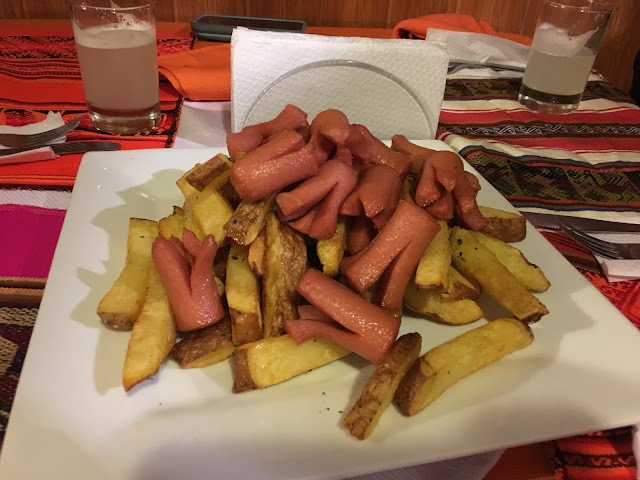Machu Picchu was the highlight of our 2019 Peru Expedition.
Aguas Calientes ("hot waters", named for the hot springs there) is the town nearest to Machu Picchu. It is squished tightly between the mountains in the only little flat part available.
When we got off our train, we were fed immediately through "the gauntlet" of colorful shops. Carrying a backpack with everything we'd need for 3 days, however, made me want to get to the hotel immediately to unload.
The hotel ended up being perfect. There was a big "quadruple" room for the girls with a window that overlooked the river and surrounding jungle.
The hotel provided us with a guide we could hire for Machu Picchu, and as we met with him that night, he put all my fears to rest and answered all my questions, which was great.
So Thursday morning, January 10, 2019, we fueled up with a breakfast provided by the hotel to get ready for our big day.
Kelsi got a Peruvian headband specifically for the occasion, and looked perfect with her Cotopaxi backpack with a llama on it (from her Questival experience).
The green mountains around the town were incredibly steep, and were offset nicely with morning mist.
Most of the family got in line for the bus while I went with the guide to get bus tickets.
The shuttle bus drove us 20 minutes up the mountain switchbacks, and we could see the sun trying hard to pierce through the typical heavy morning fog.
Finally we got our first view of some of the buildings of Machu Picchu.
Even though there was still a lot of mist, you could see some of the rich green color glowing where the sun could penetrate.
So our first family picture in front of Machu Picchu wasn't especially impressive.
Soon, though, the mist started to break, and we caught some glimpses of the "citadel" (the main buildings).
In case the above picture makes it look like we had the place to ourselves—we didn't. It was a selfie-fest.
The mornings tend to be especially crowded in Machu Picchu, especially in this area where the best overviews are had.
But we found spots where we could get some pictures without the crowds.
The tallest mountain behind Adam there is called "Wayna Picchu", and we were planning to hike to the top of it after touring the citadel. I was able to catch a nice zoomed-in shot of the peak, where you can see that a crowd of people had already made it to the top.

Just when we thought the view couldn't get any better, a rainbow appeared!
I exclaimed, "Are you kidding me!??" (Plus, now we know where the Inca hid their pot of gold...)
As we went up a little higher, the fog finally broke, and we were able to get a great picture of our whole group.
(Getting that picture was one of my main goals of the whole trip, so I was pleased when that was taken care of!)
A few minutes later, the mist rolled back through. It came and went a few times but eventually cleared up completely. It was actually magical to watch it drift across the mountain.
Oh, Erika!
As we continued around the path, we just kept getting new angles that revealed more of the terraces or buildings. People kept saying that Machu Picchu never fails to impress. They were right. And as amazing as the pictures are, it seems like the pictures still don't quite do it justice, because it's just so beautiful in every direction.
I'll shut up now and let you see some pictures.
Machu Pichu was built around 1450 A.D. as an estate for the Inca emperor Pachacuti (1438-1472). About 750 people lived there, mostly "staff" to take care of the place and serve the emperor. Analysis of skeletons indicates that the people were imported from all around Peru.
Food was grown on the many terraces, which were built with amazing drainage systems such that they can easily withstand the intense rains that are common in the area while retaining enough moisture to grow crops.
The site was abandoned about 100 years later, at the time of the Spanish conquest. (It is possible that many of the inhabitants died of smallpox). While local people knew about it, the Spanish never did, and so unlike most Inca structures, this site was never destroyed by the Spanish, thus leaving the entire complex in pristine condition.
Over the centuries that followed, the site was overgrown by the jungle. The site appears to have been found by a German guy in 1867, who helped himself to some artifacts from there; and it appears on maps as early as 1874.
In 1911, a scientist named Hiram Bingham was led to Machu Picchu by a villager, and he is credited with introducing the site to the rest of the world. He organized an expedition in 1912 to clear and excavate the site.
Below is the quarry that was used for much of the stone on the site. The quarry is located right on the site, which would have avoided having to haul the stone especially far.
Our guide took some time to explain the history of Machu Picchu and the Inca Empire to us.
The thatched roofs have all disintegrated, of course, but many of the buildings are still in great condition.

There were a lot of terraces, which could have grown enough food to support everyone. (Not recommended for playing soccer, however...)
I like the lone tree in the middle of the site.
And here's a picture of everyone exiting the doorway...
The drainage systems still work after all this time.
These little red flowers growing out of the rocks were pretty.
This building is the Temple of the Sun. It is of similar construction as the round part of the Temple of the Sun at Qorikancha in Cusco, and another one found in Pisac (in the Sacred Valley, between Ollantaytambo and Cusco). It has one window that points almost exactly in the direction of the rising sun on the June solstice in the 1400s; and another window that on that same day points at the Inca constellation "Qullqa" (storehouse) at sunset. That night, through the same window, would be seen several of the other constellations, including the llama constellation.
The altar-looking stone at the base of the room is actually the top of a massive natural stone that was already there, as seen in the next picture.

Here is the Temple of the Sun again, from below, showing the massive stone upon which it is built, and which forms the floor and altar inside the temple. This stone includes a cave underneath.
Here, Adam and Sienna show off the cave under the Temple of the Sun.
Here is one rare gap in the tight-fitting stones, where an earthquake or earth movement has caused the wall to separate.
The more important structures used the ashlar quality stone that is carefully cut to fit precisely together with all adjacent stones. Less important structures (like storage or perhaps servant's quarters) were built less expensively by fitting together existing stones, sometimes held together with mortar.
There's a lot of talk about sun worship. I actually prefer the shade, so here I am pretending to be thankful to the Shade Gods.
Some of the slabs of stone are huge, yet still fit together precisely. (Note the bottom middle stone, with 7 different lines that you can see, in order to accommodate the adjacent blocks).
And if you look close at the second opening from the right, you'll see a chinchilla hanging out there!

I saw a bunch of these protrusions on some of the blocks and wondered what they were for. Were they used to help lift the stones into place? Worn-down rock climbing wall hand-holds?
Then today I found a video of someone explaining that at least on one wall in Cusco, the shadows from some upper knobs align with lower knobs at different times of the year, like on the June and December solstices. Woah.
Did I mention how well the stones fit together, and that nobody knows how they did it?
From within the citadel, we're now looking back towards that little hut on the hill, where people usually stand to get the "classic" shot of Machu Picchu. You can see the quarry to the right, and terraces all around.
This odd-looking stone is called Inti Watana, and is thought to be a kind of sun dial. The Inca are said to have believed that the stone held the sun in its place along its annual path in the sky. At midday of the equinoxes (in September and March) the pillar casts no shadow. It is carved directly out of the underlying bedrock rather rather than carved from a stone that was moved there. There were a bunch of these around the empire, the but the Spanish purposely destroyed the others because they thought the Inca religion was blasphemous. But they didn't find this one, so neener-neener.

Our route through the citadel ended down by those two huts, where we would begin our hike to the very top of that mountain!
Here is our guide with our whole group.
At this point, we split up. By the time Leslye decided to come with us, there were no more tickets available that included the hike up to Wayna Picchu (since only 400/day are issued), so I got her a ticket that included the hike to Machu Picchu Mountain (mostly just so it would include a second entrance to the park--not because she was really going to hike that mountain). So Erika and Leslye went on a milder, shorter hike up to the Sun Gate (included with the main ticket) while the rest of us scaled Wayna Picchu.
The stairs were built by the Incas and were relentless, though the shade from the trees was nice and it was mercifully cloudy and cool for most of the hike.
We had to go down a ways before we could then hike back up the entire mountain.
There were lots of little switchbacks. We had to hurry a bit, because the top was closing at noon, and we had just one hour to make it up before that happened. That was doable, but didn't allow for long rests. (Adam wasn't feeling too well that day, so only made it about halfway before deciding to turn back).
At some places, the steps were dangerously steep. Sometimes (but not always) there were cables to grab onto at times like that.
I liked the rainbow colors of this rock.
The trail was thick with jungle growth for most of the way, but there were occasional views of Machu Picchu below.
Near the top, there was a set of terraces (perhaps so there would be enough for the watchman at the top to eat?) and a couple of structures.
Made it!
At the top there were also the intact ruins of a building with windows.
Linette got to the very top before us.
Whew!! That was a good one!
The top of Wayna Picchu Mountain is at 8800 feet, which is about 850 feet higher than Machu Picchu itself (though the hike went down and back up, so we climbed a bit more than that).
Zooming in on Machu Picchu below provides some interesting perspectives on the terraces, buildings and quarry there.
I like the diagonal path cutting across the terraces (I didn't notice that when we were walking it ourselves).
Triumph!
This panorama shows Kelsi on top of the world, with Machu Picchu way down there on the left (you might need to click and full screen that one).
Finally it was time to head back down. You can see the switchbacks that the bus has to take to get up to Machu Picchu from the town down below.
On the way back down, you make a bit of a loop that takes you through a narrow section you have to kind of squeeze through with your backpack in your hands.
And then you have to squat down to walk through a little cave so you don't bonk your head.
The stairs can be a tad dicy on the way down. I didn't ever feel too worried, but did feel like I should take it nice and easy at times. Cuz some of the stairs were seriously steep.
Meanwhile, Erika and Leslie had exited the park and re-entered in order to take a hike in the opposite direction to the Sun Gate.
They were way over on this side while we were hiking to the top of that pointy mountain over there.
This is the Sun Gate. The hike to there is about an hour round trip.
Here's a very short video showing a panorama of the area. And Leslye goofing around.
After the four of us got to the bottom of Wayna Picchu mountain, we collected Adam and walked through the bottom part of the citadel, enjoying some of the structures along the way. I thought it was cool how big stones (that were possibly already in place) were incorporated into the walls there.
This is called the "Building with the Three Doors." Probably because it has three doors.
I like the unique view of the buildings that this angle provides.
And I like the unique view of Kelsi that this angle provides.
This is an example of what the buildings might have been like with their thatched roofs intact.
After we exited the park, we re-entered (since our ticket allowed two entries) and found Erika and Leslye at our designated meeting spot.
After all that walking and exploring, we really enjoyed sitting on the edge of one of the terraces and looking down over the spectacular green valley below.
While everyone else sat on the wall, I went to play with llamas for a moment.

Then we just sat and ate snacks and laughed and stuff, which was oddly one of the nicest moments of the day.
After we all sat on the wall for a while, Linette said, "Well, if we're going to hike to the Inca Bridge, we need to go now." After a moment, Erika said, "I don't think that's necessarily true." So we sat and enjoyed dangling our feet for a few more minutes.
Eventually, we got up and headed on a 1-hour round-trip hike to the Inca Bridge. Along the way, we got more beautiful views of Machu Picchu, each with just a little different perspective than earlier ones. Maybe they start looking the same, but it kept feeling amazing, so we kept taking pictures.
The trail to the Inca Bridge went through some thick jungle with moss-covered rocks.
There's a registration desk as you enter the path so that they know if anyone didn't make it back out yet.
The trail was flat but narrow, and had steep drop-offs. Sometimes there was a little wall to provide some measure of protection.
Sometimes there was just a sheer drop and you just needed to watch your step.
Eventually the trail ends with a locked gate, allowing you to see the Inca Bridge without dying.
There was once a trail that travelled all along the sheer cliff of this mountain, with a little "drawbridge" that could be pulled up in case an enemy was using the trail.
There are some emergency steps sticking out the side of the wall you could try using if you dare. But if there were enemies trying it, they'd also be getting hit by arrows at the same time.
The steps and trail along the side of the cliff has been overgrown, and has not been cleared out nor maintained, and tourists aren't allowed there.
As you can see in this picture from the line of green growth, the trail travelled all along the mountain, with a ridiculous sheer drop next to it. Yikes!
It's hard to get a picture that captures how huge and steep and awe-inspiring the cliffs were.
When we got back down the trail and could see Machu Picchu again, Linette called out, "Randy, I found one of your friends!"
Sure enough, there were llamas around to play with.
It seems like this llama was smiling for the camera.
By this time it was about 3pm, and the crowds were almost all gone. Most people do the morning schedule and often need to catch trains that afternoon. We purposely spent two nights here so that we would have no pressure to be anywhere else and could just enjoy our day here.
What a happy time.
Gotta love the llamas joining the picture.
Here's a little attempt at an artistic panorama video.
After being pleasantly cool and cloudy all day, it finally started to rain a little as we prepared to go. So we all pulled out ponchos that we finally got to put to use, and then made our way out of the park.
Here's a little video Kelsi made out of a few clips from the day. I liked how it captured the sounds and mood. You can even see a little of the rain at the end.
Adam and Sienna decided to take the bus down. The other five of us decided to walk down the steps.
The stairs down were indeed steep and at this point slippery, and it took over an hour, so we weren't sure it was worth it. (I guess it was my one way to rebel against the bus monopoly that charged $12 for a 20-minute ride when everywhere else in Peru that would be more like $1. Someone said this was the most expensive bus ride per kilometer in South America. And we figured "Now we've got an extra $60 to spend on dinner!" ).
The way down included one set of the Inca stairs that stick out of the wall.
Here's a map showing the switchbacks the busses take (in black) and the path that we took (in green).
Finally we got to the bottom and were pretty worn out by that point.
Fortunately, we had nowhere else to be that day, so we could just mosey back to the hotel, rest up, and go find some food.
We ended up choosing a restaurant that was highly rated on TripAdvisor, and it was indeed good.
We got some salchipapas for Adam and Sienna to try. They were a little scarier-looking than the ones we had in Huánuco.
My chimichangas were a great success. (Tortillas aren't really used in Peru, but they're made here to cater to the international crowd).
After all that walking and not much eating, almost everything tasted great.
Machu Picchu was a tricky place to get to, and before the trip I had been worried about all the things that could have gone wrong to mess it up, but things turned out wonderfully. We were so happy to have made it there and experienced that incredible place.
This was definitely the highlight of the trip. Everything afterwards felt like just winding things down so we could get back home. In the last episode, we see a few more things in Cusco, explore Lima a little, and get back home.


















































































































































































No comments:
Post a Comment